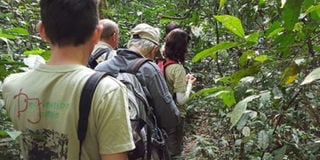Save Bugoma forest reserve to conserve the ecosystem

Bugoma Forest is a protected tropical forest situated southwest of Hoima and northeast of Kyenjojo. The forest, gazetted in the 1930s, came under the mandate of the National Forestry Authority in 2003. According to the Fortune of Africa, the forest is endowed with a high biodiversity with 24 species of mammals, 465 species of trees, 359 species of birds, 289 species of butterfly and 130 species of moths (Forest Department 196a).
The mammals include monkeys, chimpanzees, buffaloes, Uganda kobs and at times elephants. Lake Albert and River Nkusi are also the major attractions. There are also eco-tourism sites at Busingiro and Kaniyo Pabidi.
However, media reported that the court ruling okayed the destruction of 22-square miles of Bugoma Central Forest Reserve for sugarcane growing after court dismissing the case filed by National Forestry Authority in which it was claiming ownership.
Uganda loses about 100,000 hectares of forests cover every year, a situation that is worsening the effects of climate change. Uganda is party to the global framework addressing climate change and domesticated its commitment in Vision 2040.
Uganda is also one of the 175 countries that signed the Paris Agreement to keep the global temperatures rise below two degrees Celsius and, if possible, 1.5 degrees Celsius.
However, the rate of deforestation is high and forests are disappearing. As an environmental engineer and conservationist, the decision is not only a threat to the endangered ecosystem but also will negatively affect the tourism sector which is a source of revenue for the communities and the country at large.
The battle over Bugoma Forest between the National Forestry Authority and Bunyoro Kingdom, which is accused of giving away the contested forest to pave way for sugarcane growing by Hoima Sugar Limited, is dangerous to the tourism sector. The destruction and change in the use of the habitat will affect the climate, the water sources, and the entire economy of the area. In particular, sugarcane growing will worsen the remaining existence of natural habitat and its wildlife with more conflicts between humans and wildlife as well as impoverishing the local communities.
Therefore, sugarcane growing should not take place at the expense of a natural resource. What Bugoma Forest and local communities need is development, However, development, which can be there when there is certainty of land use and ownership by the government of Uganda.
The decision of having part of the natural forest cleared for sugarcane purpose does not make sense because you can’t make a comparison of sugarcane plantation and conserving the forest given that tourism remains one of the top foreign exchange earners for Uganda.
The government of Uganda must re-establish its ownership for the entire central forest reserve to save the endangered ecosystem and promote environmental conservation.
Patrick Edema,
[email protected]




